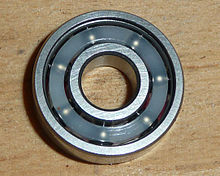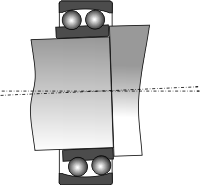
Back Diyircəkli yastıq Azerbaijani Kuglloga BAR بۆڵبەرینگ CKB Kuličkové ložisko Czech Pêl-feryn Welsh Kugleleje Danish Kugellager German Rodamiento de bolas Spanish Errodamendu boladun Basque بلبرینگ Persian




Ball bearings consist of spherical rolling elements placed between two rings, known as races.[1] These balls roll smoothly within the races, minimizing friction and allowing for the efficient transfer of loads. A ball bearing is a type of rolling-element bearing that uses balls to maintain the separation between the bearing races. These type of bearings also contain a cage which is a separator that maintains equal spacing between the balls, ensuring even load distribution.[2]
The purpose of a ball bearing is to reduce rotational friction and support radial and axial loads. It achieves this by using at least two races to contain the balls and transmit the loads through the balls. In most applications, one race is stationary and the other is attached to the rotating assembly (e.g., a hub or shaft). As one of the bearing races rotates it causes the balls to rotate as well. Because the balls are rolling they have a much lower coefficient of friction than if two flat surfaces were sliding against each other.
Ball bearings tend to have lower load capacity for their size than other kinds of rolling-element bearings due to the smaller contact area between the balls and races. However, they can tolerate some misalignment of the inner and outer races.
- ^ Jain, Dhrriti (7 May 2023). "Ball Bearings vs Roller Bearings – Detailed Comparison". The Bearings Chronicle - Learn about Ball Bearings and Roller Bearings.
{{cite web}}: CS1 maint: url-status (link) - ^ Jain, Dhrriti (7 May 2023). "Ball Bearings vs Roller Bearings – Detailed Comparison". The Bearings Chronicle - Learn about Ball Bearings and Roller Bearings.
{{cite web}}: CS1 maint: url-status (link)
© MMXXIII Rich X Search. We shall prevail. All rights reserved. Rich X Search